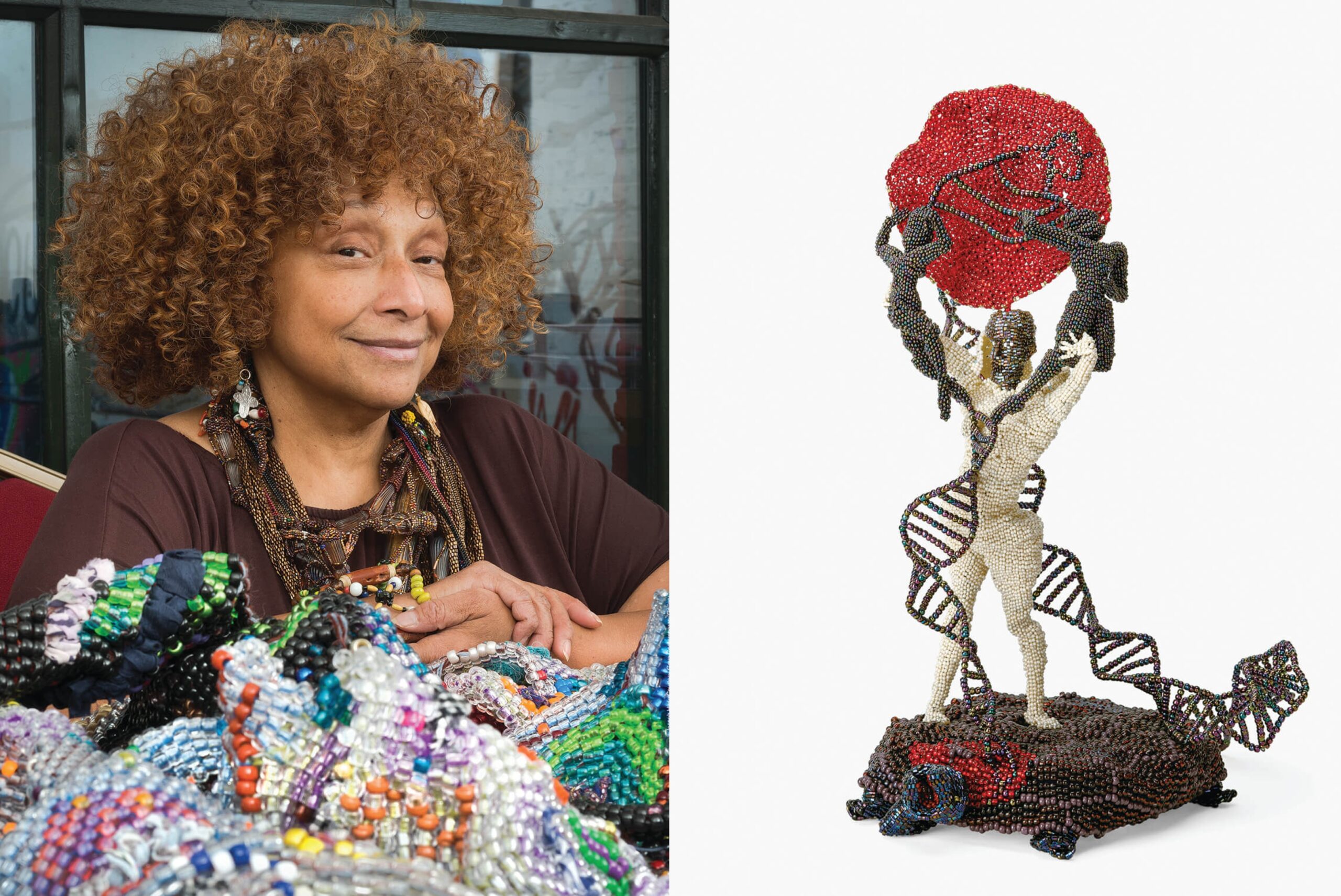Arts & Culture
Joyce J. Scott Discusses Highlights of New BMA Retrospective
“Joyce J. Scott: Walk a Mile in My Dreams,” a 50-year career retrospective of one of the country’s most important working artists, opens March 24.

Sandtown-born Joyce Scott learned quilting from her mother, Elizabeth Talford Scott, who learned it from her mother, on the South Carolina plantation where she grew up among a family of sharecroppers. Both went on to acclaimed careers as mixed-media fiber artists, though Joyce, named a 2016 MacArthur Fellow and 2019 Smithsonian Visionary Artist, became more renown for her figurative statues, her jewelry, bead, and glasswork—and, in Baltimore, the massive Memorial Pool installation at Druid Hill Park, which honors the park’s historic segregated swimming pool.
In 2018, the ever-evolving Scott created a towering 15-foot sculpture of Harriet Tubman with a mixture of soil, clay, and straw that was designed to disintegrate into the land near where Tubman led enslaved people to freedom.
With all this and more in mind, the Baltimore Museum of Art presents a 50-year career retrospective of one of the country’s most important working artists today. “Joyce J. Scott: Walk a Mile in My Dreams” opens as a special ticketed exhibition March 24 and runs through July 14 before moving to the Seattle Art Museum.
I recently saw the BMA’s exhibition of your late mother’s work, which will run concurrently with yours through April. The combination builds on your joint 2019 BMA show: “Hitching Dreams to Untamed Stars.”
My mother was born in 1916 and saw amazing change in the world. I lived with her until she passed away [in 2011]. I went to graduate school and traveled and those things, but we were very close. We had that through line of the visual and performing arts, which gave us something to relate to, to talk about, and to build on. For some people, it’s cooking, but for us, art was our conspiracy and our invitation to others. Because once we make it, we share it.
The BMA tells us you’re creating a site-specific installation at the entrance of the retrospective. A small house?
I don’t know what drove this, except I was thinking of a sweat lodge or a gathering space where people would commune in the everyday sense, but also maybe spiritually. It’s a huge four-sided building—picture a yurt—that has quilts on the outside. One in each panel of my mother, grandfather, grandmother, and godmother. The inside is turned out with beaded pieces I did…There’s also a figure who is holding a needle and reaching out with the thread, which represents where I came from and the way that I give as an artist and teacher. And there’s a chair covered in books and tchotchkes from my life that have influenced me.
And you and others may appear inside the “yurt,” greeting people and performing?
Yes, it’s a place where I can sit or, if a storyteller or musician comes in, they can sit and commune with visitors. Sometimes I’m going to come and just sit and talk trash until they throw me out. The guards are already giving me the stink eye.
That’s funny. Can I ask about the nature and themes of your work? How craft or folk art blends with so-called high art or fine art? There are quilts, figurative statues—which are intricately done—jewelry, clothes, dolls. But the titles, “Strange Fruit,” “None Are Free Until All Are Free,” “Lynching Necklace,” make you look twice and reflect on what at first glance may not be obvious.
I’m an artist-craftsperson. I don’t separate them. I’m always doing both. It’s the same impulse, the same creative feeling or setting that makes me make a cup and makes me make a piece of sculpture. There’s not a hierarchy that I ascribe to. I’ve always liked figures and my mom was a doll-maker, too. The work must be created wonderfully, not always beautifully, just wonderfully, so that the person is mesmerized by it. Then they realize, that’s a lynching, or that person is shooting a gun.
You’ve traveled to Africa, Europe, Asia, South America, mixing these diverse influences into different mediums. At the same time, it all remains, intrinsically, your art.
That’s it. I don’t want to be a one-trick pony. I don’t want to be a pony at all…My best voice for communication is as an artist and those influences [and mediums] represent different approaches to art and life that hopefully make me a better person, a more well-rounded, approachable, knowledgeable person. I can’t say it’s enough that I’m alive, that I should eat good food, look good. I think I’m supposed to be on this quest. I feel I am supposed to make this world better for others in whatever way I can.